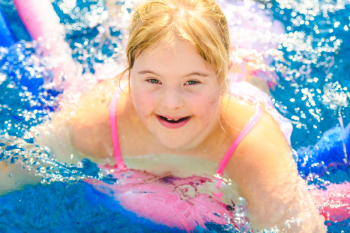For many Iowa families, summer means pool days, lake trips, and time spent cooling off in the water. But with all that fun comes a common seasonal problem parents should watch for: swimmer’s ear. This outer ear infection is especially common in kids during warm months. While usually not serious, it can cause pain, disrupt summer plans, and lead to complications if untreated. Knowing the signs and how to act helps your child recover quickly and enjoy summer.
What causes swimmer’s ear?
Swimmer’s ear, or otitis externa, is an infection of the ear canal—the passage between the outer ear and eardrum. It happens when water gets trapped after swimming or bathing, creating a moist environment where bacteria or fungi thrive. Kids are more prone because their ear canals are smaller and hold water more easily. Add Iowa’s warm, humid weather and frequent swimming, and the risk goes up.
prone because their ear canals are smaller and hold water more easily. Add Iowa’s warm, humid weather and frequent swimming, and the risk goes up.
Other risk factors include:
- Cleaning ears too aggressively with cotton swabs
- Wearing earbuds or hearing aids that cause friction
- Existing skin conditions like eczema or psoriasis
- Swimming in untreated or dirty water
Signs and symptoms to watch for
The most common symptom of swimmer’s ear is ear pain, especially when the ear is touched or tugged. Other signs may include:
- A feeling of fullness or pressure in the ear
- Itching inside the ear canal
- Clear or yellowish drainage
- Temporary hearing loss or muffled hearing
- Swelling or redness around the outer ear
In more advanced cases, children may develop fever or experience significant swelling that blocks the ear canal. If symptoms are severe or don’t improve within a few days, it’s important to contact an Iowa ENT Center specialist for expert evaluation and care.
How to treat swimmer’s ear
Fortunately, swimmer’s ear is highly treatable. At Iowa ENT Center, our specialists will examine your child’s ear and may prescribe antibiotic or steroid ear drops to reduce inflammation. In some cases, gentle ear cleaning may be needed to help the medication reach the infected area.
To help your child heal, it’s important to:
- Keep the ear dry while it’s healing (this means no swimming for a few days)
- Avoid inserting anything into the ear, including cotton swabs
- Follow the full course of prescribed medication
Pain relievers like acetaminophen or ibuprofen can help manage discomfort while the infection clears.
Preventing future infections
Once your child has had swimmer’s ear, you’ll want to help prevent it from coming back. Try these simple prevention tips:
- Tilt the head after swimming to help water drain
- Gently dry ears with a towel after water activities
- Avoid cotton swabs or inserting anything into the ear
- Use over-the-counter drying drops after swimming
- Try swimming earplugs if your child is in the water often
Avoiding prolonged exposure to dirty or untreated water can also lower the risk of infection.
When to see a specialist
While many cases of swimmer’s ear can be managed at home, some children need extra care—especially if infections become frequent or more severe. If your child has recurring ear pain, trouble hearing, or other ENT concerns, it’s important to see a specialist at Iowa ENT Center for expert evaluation and treatment.
At Iowa ENT Center, our team provides expert care for children dealing with swimmer’s ear and other common ENT conditions. We work to quickly identify the issue and provide effective, personalized treatment, helping your child feel better and return to their favorite summer activities. Schedule a consultation today by calling us at 515-223-4368.
